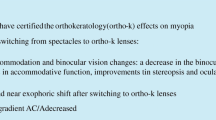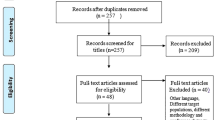Abstract
Purpose
To investigate whether preoperative retinal function measured by full-field ERG and multifocal ERG is correlated to postoperative visual acuity after macular hole surgery.
Methods
Standard pars plana vitrectomy with removal of the internal limiting membrane (ILM) was performed on 19 consecutive patients undergoing macular hole surgery. Intraocular gas tamponade with a C2F6 gas–air mixture was employed, followed by a face-down position for at least 5 days. The patients were examined with the ETDRS chart, full-field ERG (Espion), multifocal ERG (Veris 6), and optical coherence tomography (OCT) preoperatively, and 6 weeks, 6 months, and 18 months after surgery.
Results
The cone 30-Hz flicker implicit time in the full-field ERG reflecting retinal function was prolonged (p = 0.016) before surgery compared to aged-matched controls. After macula hole surgery, longstanding alteration of cone function reflected by mfERG and full-field ERG was verified 18 months after surgery. The prolonged cone 30-Hz flicker implicit time in the full-field ERG before surgery was significantly correlated to the ETDRS visual acuity 6 months postoperatively (p = 0.03).
Conclusions
Preoperative evaluation of retinal function with multifocal ERG and full-field ERG improves the understanding of the retinal recovery process after macular hole surgery. The cone implicit time in full-field 30-Hz flicker ERG could be a valid predictor of long-term visual outcome, which may be useful for selecting patients suitable for surgery.



Similar content being viewed by others
References
Kelly NE, Wendel RT (1991) Vitreous surgery for idiopathic macular holes. Results of a pilot study. Arch Ophthalmol 109(5):654–659
Dimopoulos IS, Tennant M, Johnson A, Fisher S, Freund PR, Sauvé Y (2013) Subjects with unilateral neovascular AMD have bilateral delays in rod-mediated phototransduction activation kinetics and in dark adaptation recovery. Invest Ophthalmol Vis Sci 54(8):5186–5195
Moschos M, Apostolopoulos M, Ladas J, Theodossiadis P, Malias J, Moschou M, Papaspirou A, Theodossiadis G (2001) Multifocal ERG changes before and after macular hole surgery. Doc Ophthalmol 102(1):31–40
Scupola A, Mastrocola A, Sasso P, Fasciani R, Montrone L, Falsini B, Abed E (2013) Assessment of retinal function before and after idiopathic macular hole surgery. Am J Ophthalmol 156(1):132–139
Yip YW, Fok AC, Ngai JW, Lai RY, Lam DS, Lai TY (2010) Changes in first- and second-order multifocal electroretinography in idiopathic macular hole and their correlations with macular hole diameter and visual acuity. Graefes Arch Clin Exp Ophthalmol 248(4):477–484
Birch DG, Jost BF, Fish GE (1988) The focal electroretinogram in fellow eyes of patients with idiopathic macular holes. Arch Ophthalmol 106(11):1558–1563
Tosi GM, Martone G, Balestrazzi A, Malandrini A, Alegente M, Pichierri P (2009) Visual field loss progression after macular hole surgery. J Ophthalmol 2009:617891
Ezra E, Arden GB, Riordan-Eva P, Aylward GW, Gregor ZJ (1996) Visual field loss following vitrectomy for stage 2 and 3 macular holes. Br J Ophthalmol 80(6):519–525
Ueno S, Kondo M, Piao CH, Ikenoya K, Miyake Y, Terasaki H (2006) Selective amplitude reduction of the PhNR after macular hole surgery: ganglion cell damage related to ICG-assisted ILM peeling and gas tamponade. Invest Ophthalmol Vis Sci 47(8):3545–3549
Shah SP, Manjunath V, Rogers AH, Baumal CR, Reichel E, Duker JS (2013) Optical coherence tomography-guided facedown positioning for macular hole surgery. Retina 33(2):356–362
Haritoglou C, Reiniger IW, Schaumberger M, Gass CA, Priglinger SG, Kampik A (2006) Five-year follow-up of macular hole surgery with peeling of the internal limiting membrane: update of a prospective study. Retina 26(6):618–622
Rao X, Wang NK, Chen YP, Hwang YS, Chuang LH, Liu IC, Chen KJ, Wu WC, Lai CC (2013) Outcomes of outpatient fluid-gas exchange for open macular hole after vitrectomy. Am J Ophthalmol 156(2):326–333
Tavolato M, Lo Giudice G, Cian R, Galan A (2013) Outcomes of 195 consecutive patients undergoing 2-port pars plana vitrectomy with slit-lamp illumination system for posterior segment disease: a retrospective study. Retina 33(4):785–790
Marmor MF, Fulton AB, Holder GE, Miyake Y, Brigell M, Bach M (2009) Standard for clinical electroretinography. Doc Ophthalmol 118:69–77
Gerth C (2009) The role of the ERG in the diagnosis and treatment of age-related macular degeneration. Doc Ophthalmol 118(1):63–68
Si YJ, Kishi S, Aoyagi K (1999) Assessment of macular function by multifocal electroretinogram before and after macular hole surgery. Br J Ophthalmol 83(4):420–424
Terasaki H, Miyake Y, Nomura R, Piao CH, Hori K, Niwa T, Kondo M (2001) Focal macular ERGs in eyes after removal of macular ILM during macular hole surgery. Invest Ophthalmol Vis Sci 42(1):229–234
Szlyk JP, Vajaranant TS, Rana R, Lai WW, Pulido JS, Paliga J, Blair NP, Seiple W (2005) Assessing responses of the macula in patients with macular holes using a new system measuring localized visual acuity and the mfERG. Doc Ophthalmol 110(2–3):181–191
Purtskhvanidze K, Treumer F, Junge O, Hedderich J, Roider J, Hillenkamp J (2013) The long-term course of functional and anatomical recovery after macular hole surgery. Invest Ophthalmol Vis Sci 54:4882–4891
Wallentén KG, Andréasson S, Ghosh F (2008) Retinal function after vitrectomy. Retina 28(4):558–563
Schatz P, Andréasson S (2010) Recovery of retinal function after recent-onset rhegmatogenous retinal detachment in relation to type of surgery. Retina 30(1):152–159
Schatz A, Breithaupt M, Hudemann J, Niess A, Messias A, Zrenner E, Bartz-Schmidt KU, Gekeler F, Willmann G (2013) Electroretinographic assessment of retinal function during acute exposure to normobaric hypoxia. Graefes Arch Clin Exp Ophthalmol 252(1):43–50
Tuzson R, Varsanyi B, Vince Nagy B, Lesch B, Vámos R, Németh J, Farkas A, Ferencz M (2010) Role of multifocal electroretinography in the diagnosis of idiopathic macular hole. Invest Ophthalmol Vis Sci 51(3):1666–1670
Alkabes M, Padilla L, Salinas C, Nucci P, Vitale L, Pichi F, Burès-Jelstrup A, Mateo C (2013) Assessment of OCT measurements as prognostic factors in myopic macular hole surgery without foveoschisis. Graefes Arch Clin Exp Ophthalmol 251(11):2521–2527
Itoh Y, Inoue M, Rii T, Hiraoka T, Hirakata A (2012) Correlation between length of foveal cone outer segment tips line defect and visual acuity after macular hole closure. Ophthalmology 119(7):1438–1446
Larsson J, Andreasson S, Bauer B (1998) Cone b-wave implicit time as an early predictor of rubeosis in central retinal vein occlusion. Am J Ophthalmol 125(2):247–249
Tyrberg M, Lindblad U, Melander A, Lövestam-Adrian M, Ponjavic V, Andréasson S (2011) Electrophysiological studies in newly onset type 2 diabetes without visible vascular retinopathy.Doc. Ophthalmol 123(3):193–198
Tzekov R, Arden GB (1999) The electroretinogram in diabetic retinopathy. Surv Ophthalmol 44(1):53–60
Acknowledgments
The authors thank Boel Nilsson and Ing-Marie Holst for their skilful technical assistance in the full-field ERG and mfERG measurements. This study was supported by grants from the Swedish Medical Research Council, The Swedish Association of the Visually Impaired, and Skane County Council Research. This study was partially presented at the Gonin Meeting in Reykjavik in 2012.
Conflict of interest
None.
Author information
Authors and Affiliations
Corresponding author
Rights and permissions
About this article
Cite this article
Andréasson, S., Ghosh, F. Cone implicit time as a predictor of visual outcome in macular hole surgery. Graefes Arch Clin Exp Ophthalmol 252, 1903–1909 (2014). https://doi.org/10.1007/s00417-014-2628-0
Received:
Revised:
Accepted:
Published:
Issue Date:
DOI: https://doi.org/10.1007/s00417-014-2628-0




